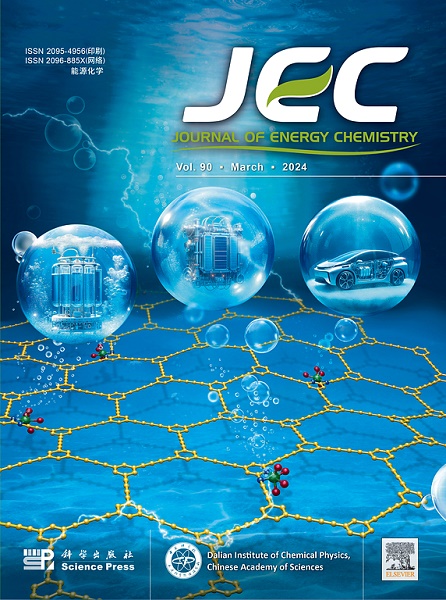Chemometrics-boosted protocols for effortless evaluation of factors affecting the electrochemical nitrate reduction to ammonia
IF 13.1
1区 化学
Q1 Energy
引用次数: 0
Abstract
Food production demand is constantly growing, entailing a proportional increment in fertilisers and pharmaceuticals use, which are eventually introduced to the environment, leading, among others, to an imbalance in the nitrogen cycle. Electrochemical nitrate reduction reaction is a delocalised route for nitrates elimination and green ammonia production. In the present study, we carry out nitrates electroreduction over a commercial MoS2 catalyst, focusing on optimising selected input factors affecting the reaction. Concretely, Doehlert design of experiment and response surface methodology are employed to find the proper combination of supporting salt concentration in the electrolyte, applied potential, and catalyst loading at the working electrode, with the overall aim to boost Faradaic efficiency (FE) and ammonia production. As a matter of fact, varying these input factors, the obtained FE values ranged from ∼2% to ∼80%, highlighting the strength of the newly conceived approach. Moreover, our multivariate strategy allows the quantification of each factor effect and elucidates hidden interactions between them. Finally, successful extended durability tests are performed for 100 h at both FE and productivity (P) optimal conditions. In parallel, cell electrodes are characterised by in-depth structural, morphological, and surface techniques, before and after ageing, overall demonstrating the outstanding stability of the proposed electrochemical reactor.

化学计量学促进了对影响电化学硝酸还原为氨的因素的毫不费力的评估
粮食生产需求不断增长,导致化肥和药品的使用按比例增加,这些肥料和药品最终进入环境,除其他外,导致氮循环失衡。电化学硝酸还原反应是消除硝酸盐和绿色制氨的脱域途径。在本研究中,我们在商业二硫化钼催化剂上进行硝酸盐电还原,重点是优化影响反应的输入因素。具体而言,采用Doehlert实验设计和响应面法寻找电解液中负载盐浓度、外加电位和工作电极催化剂负载的合理组合,以提高法拉第效率(FE)和氨产量。事实上,改变这些输入因素,获得的FE值范围从~ 2%到~ 80%,突出了新构思方法的强度。此外,我们的多元策略可以量化每个因素的影响,并阐明它们之间隐藏的相互作用。最后,在FE和生产率(P)最佳条件下进行了100小时的成功延长耐久性试验。同时,在老化前后,通过深入的结构、形态和表面技术对电池电极进行了表征,总体上证明了所提出的电化学反应器的卓越稳定性。
本文章由计算机程序翻译,如有差异,请以英文原文为准。
求助全文
约1分钟内获得全文
求助全文
来源期刊

Journal of Energy Chemistry
CHEMISTRY, APPLIED-CHEMISTRY, PHYSICAL
CiteScore
19.10
自引率
8.40%
发文量
3631
审稿时长
15 days
期刊介绍:
The Journal of Energy Chemistry, the official publication of Science Press and the Dalian Institute of Chemical Physics, Chinese Academy of Sciences, serves as a platform for reporting creative research and innovative applications in energy chemistry. It mainly reports on creative researches and innovative applications of chemical conversions of fossil energy, carbon dioxide, electrochemical energy and hydrogen energy, as well as the conversions of biomass and solar energy related with chemical issues to promote academic exchanges in the field of energy chemistry and to accelerate the exploration, research and development of energy science and technologies.
This journal focuses on original research papers covering various topics within energy chemistry worldwide, including:
Optimized utilization of fossil energy
Hydrogen energy
Conversion and storage of electrochemical energy
Capture, storage, and chemical conversion of carbon dioxide
Materials and nanotechnologies for energy conversion and storage
Chemistry in biomass conversion
Chemistry in the utilization of solar energy
 求助内容:
求助内容: 应助结果提醒方式:
应助结果提醒方式:


